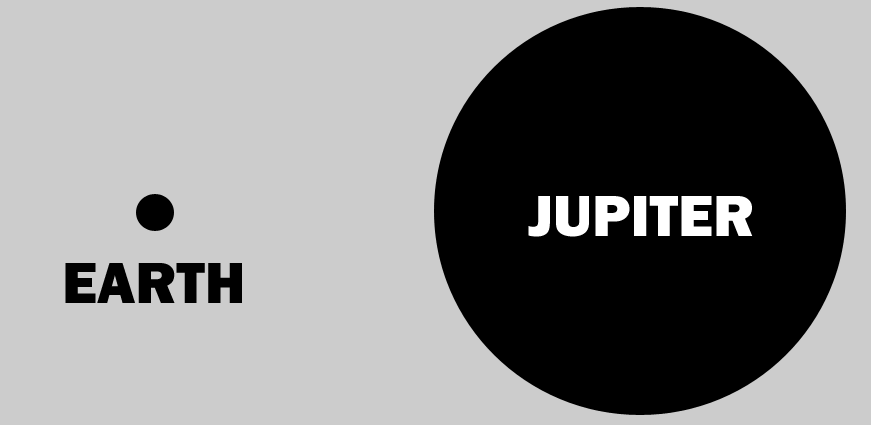JUPITER
Earth - Jupiter Size Comparison

- The Bringer of Jollity Jupiter is the fifth planet from the Sun, the largest in the solar system.
- In mythology, Jupiter (also known as Jove or Zeus) was the King of the Gods, the ruler of Olympus and the patron of the Roman state. Zeus was the son of Cronus (Saturn).
- If Jupiter were hollow, more than one thousand Earths could fit inside. It also contains more matter than all of the other planets combined. It has a mass of 1.9 x 1027 kg and is 142,800 kilometers (88,736 miles) across the equator. Jupiter possesses 16 satellites, four of which - Callisto, Europa, Ganymede and Io - were observed by Galileo as long ago as 1610. There is a ring system, but it is very faint and totally invisible from the Earth. (The ring was discovered in 1979 by Voyager 1.)
- The atmosphere is very deep, perhaps comprising the whole planet, and is somewhat like the Sun. It is composed mainly of hydrogen and helium, with small amounts of methane, ammonia, water vapor and other compounds. Deep within Jupiter, the pressure is so great that the hydrogen atoms are broken up and the electrons are freed so that the resulting atoms consist of bare protons. This produces a state in which the hydrogen becomes metallic.
- Jupiter was first visited by Pioneer 10 in 1973 and later by Pioneer 11, Voyager 1, Voyager 2 and Ulysses. The spacecraft Galileo is currently in orbit around Jupiter and will be sending back data until at least 2010.
- Colorful latitudinal bands, atmospheric clouds and storms illustrate Jupiter's dynamic weather systems. The cloud patterns change within hours or days. The Great Red Spot is a complex storm moving in a counter-clockwise direction. At the outer edge, material appears to rotate in four to six days; near the center, motions are small and nearly random in direction. An array of other smaller storms and eddies can be found throughout the banded clouds.
- Auroral emissions, similar to Earth's northern lights, were observed in the polar regions of Jupiter. The auroral emissions appear to be related to material from Io that spirals along magnetic field lines to fall into Jupiter's atmosphere. Cloud-top lightning bolts, similar to superbolts in Earth's high atmosphere, were also observed.
- In July 1994, Comet Shoemaker-Levy 9 collided with Jupiter with spectacular results. The effects were clearly visible even with amateur telescopes. The debris from the collision was visible for nearly a year afterward with HST. Jupiter's Ring Unlike Saturn's intricate and complex ring patterns, Jupiter has a single ring that is almost uniform in its structure. It is probably composed of dust particles less than 10 microns in diameter-about the size of cigarette smoke particles. It extends to an outer edge of about 129,000 kilometers (80,161 miles) from the center of the planet and inward to about 30,000 kilometers (18,642 miles). The origin of the ring is probably from micrometeorite bombardment of the tiny moons orbiting within the ring.
- Jupiter's ring and moons exist within an intense radiation belt of electrons and ions trapped in the planet's magnetic field. These particles and fields comprise the jovian magnetosphere or magnetic environment, which extends 3 to 7 million kilometers (1.9 to 4.3 million miles) toward the Sun, and stretches in a windsock shape at least as far as Saturn's orbit-a distance of 750 million kilometers (466 million miles).
- The Galileo atmospheric probe discovered a new intense radiation belt between Jupiter's ring and the uppermost atmospheric layers. This new belt is approximately 10 times as strong as Earth's Van Allen radiation belts. Surprisingly, this new belt was also found to contain high energy helium ions of unknown origin.
BACK
RETURN TO SOLAR SYSTEM